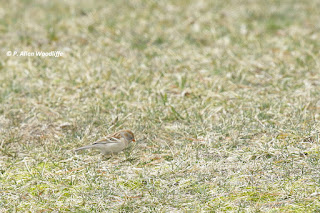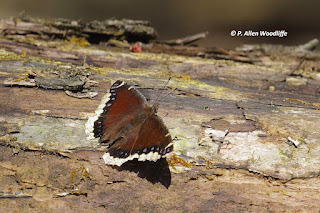The park was quiet. It was just after 8 a.m. and the deer hadn't ventured back into the more wooded areas yet; more than a dozen were still out in the wide open spaces.
Sparrows are back in good numbers. I noticed lots of Song Sparrows and an occasional Field Sparrow, but any Chipping Sparrows that were seen by others on previous days eluded me.
While photographing this Field Sparrow from the van window, I heard a Pileated Woodpecker call not far away. In a few minutes it appeared, and in fact flew right towards me, just about 5 metres over my head. I wasn't quick enough with the camera out the window, but the sky was very bland and a mostly black bird against a bright gray sky would not have been a great shot anyway. The female flew out just a few minutes later and at least had the decency to land in a tree so I could see a bit of her, and I managed to get this next photo. It has been heavily cropped to eliminate the undesirable background.
As I drove slowly along Lakeshore Road looking for more sparrows and such, I noticed this American Woodcock right at the edge. It bounced and danced on the spot before slowly working its way back into the shrubbery. This next photo is not cropped at all.
There are lots of Killdeer scattered around. This one was hanging out on a parking barrier.
I saw several Turkey Vultures soaring overhead, which isn't surprising since they had arrived in southern Ontario in good numbers over the last week or so. This one was apparently having a picnic in the picnic area, helping park staff clean up some of the carcasses and debris. The carcass looked a little desiccated; I'm not sure how much nutrition the vulture got out of it.
Eastern Phoebes are widely scattered, along the trails, and along the roadsides. I noted about 10, but I expect there were several times that many throughout the park away from the trails and roads. Getting one to stay still for a photograph does not come easy.
As the day wore on, the sun came out and warmed things up nicely. I saw an Eastern Comma along Spicebush Trail, but it was constantly on the move. This photo was from another time.
The sloughs along the trails were quite active with frogs. I heard and saw lots of Wood Frogs and heard the occasional Spring Peeper. |
| Wood Frog |
This Leopard Frog was a little confused. It was sitting on the white paint at a stop sign. I'm sure the darker pavement would have been slightly warmer since it absorbs the heat from the sun, whereas the white paint reflects it.
Yesterday I went up to Bickford Oak Woods (BOW) in west central Lambton County. It is an intriguing property....a Conservation Reserve managed by MNR&F. There aren't any official trails, just a few very old logging trails, and only a couple of small parking lots. It is about 308 hectares (761 acres) of mixed lowland and upland forest. There is very little topographic relief but being on heavy clayey soils, it holds surface water very well, so any slightly lower area supports lowland vegetation. There are two small prairie plantings for extra diversity, which were planted on the section of former agricultural land between the parking area and the woodland. It makes a nice transition and is a great spot in season for butterflies and dragonflies.
The goal of my trip this day was to check out the stand of Swamp Cottonwood (Populus heterophylla). BOW is the only location in Canada where this species is known to occur. It was discovered as recently as 2002 by none other than Gerry Waldron, John Ambrose and Lindsay Rodger. While I was with MNR, I contracted them to do a vegetation inventory of this site as it was being promoted as a Conservation Reserve.
The location of the Swamp Cottonwood is not all that hard to find if you know where it is. And that is the challenge. It involves about three kilometres (round-trip) of hiking through the prairie patch, following the edge of the woods, then accessing an old muddy logging trail to get through wet woods, traversing a creek that usually has lots of water in it. And once you get there, you are standing in water, which isn't surprising since after all it is 'Swamp' Cottonwood. The water was about 30 cm deep at the time of this visit, but with the heavy rains in the days since, undoubtedly is much deeper. These next two photos show the Swamp Cottonwood in its preferred habitat, with a dense Buttonbush thicket in the background.
All in all it was a wonderful time, not only because I was amongst a grove of one of the rarest trees in Canada, but due to the time of year and the bright sunshine, there was a very loud chorus of Chorus Frogs along with a few Wood Frogs in this swamp busily calling to attract a mate. In fact it was so loud it drowned out the sounds of truck traffic on Hwy 40, about a kilometre away.
There were a few other things I noted along the way, including at least three Eastern Commas and my first of year Mourning Cloak.
Other wildlife was relatively minimal, with only a few birds (Red-tailed Hawk, Eastern Phoebe, Song Sparrow, Am Tree Sparrow, etc) noted, and a couple of White-tailed Deer which acted like they hadn't seen anyone for a long time. Chances are given the relative lack of human visitation to this Conservation Reserve, they hadn't seen any humans since the hunting season of last year.I did see a couple of Snowy Owls along Winter Line on the way home. Up to 7 or more have been in that area for much of the winter, but I expect these holdouts will be gone soon. As much as I liked this Snowy Owl photo currently on my blog header, I will be changing that pic very soon to something more appropriate for the season.
















Sounds like quite the trek to see the Cottonwood! I'll have to visit BOW sometime. With the mobility of Cottonwood seeds I wonder what potential there could be for new populations to pop up in nearby swamps.
ReplyDeleteIt can seem a little daunting to get to it, but in reality not all that bad if one has a bit of patience. This grove has been there for some time....several decades at least, and it does make one wonder if it occurs elsewhere waiting to be discovered.
DeleteBeen a long time since I have looked at the Swamp Cottonwoods. I would imagine it is extremely wet there now with all the rain the last couple of days!
ReplyDeleteI purposely went when I did, thinking that the 5+ cm of rain we got at the end of the week would make traversing the Lambton clayey soils a lot more challenging!
Delete